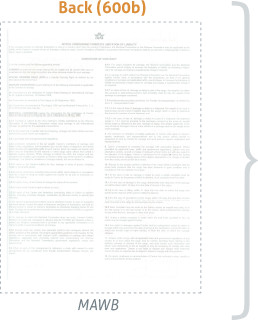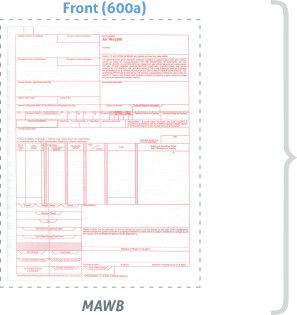|
 |
|
| |
 |
|
| |
 |
| SIGN AGREEMENT |
The back of the paper AWB contains the contract between the freight forwarder and the carrier. With e-AWB this contract may be replaced by IATA’s Multilatral agreement signed by the carrier and the freight forwarder. |
|
 |
|
|
| |
|
|
| |
The new IATA Multilateral e-AWB Agreement (resolution 672) provides a single standard agreement that airlines and freight forwarders can sign once with IATA to enter into e-AWB agreements with all parties, without having to sign numerous bilateral agreements. |
|
|
| |
|
 |
|
The Multilateral e-AWB Agreement provides the Legal framework for parties to conclude cargo contracts by electronic means
It includes provisions for:
- The consent to do e-AWB
- The high level operational aspects for e-AWB
- The confidentiality and security of data
- The rights and obligations of parties
|
|
 |
|
- the conditions of contract
- the conditions of carriage
|
|
|
|
| |
|
|
 |
|
 |
|
| |
 |
|
| |
 |
|
Electronic Data Interchange (EDI), enables the computer system from one company to communicate to the computer system of another company and digitally exchange data.
Among all the data/messages that are inter exchanged between the freight forwarder and the air carrier, there are some pertinent to e-AWB. The most important ones are the FWB and FHL messages:
The FWB – Air Waybill data update - contains the physical information of the shipment and all other details that come in the front of the paper AWB.
The FHL – consolidations list - provides the information of the house AWBs. |
|
|
| |
|
|
| |
| The freight forwarder can connect to LAN CARGO’s systems in two ways: |
|
For e-AWB implementation, Freight Forwarder must have the capability to send electronic data (FWB & FHL) to LAN CARGO and receive electronic data (FNA & FMA & RCS) from LAN CARGO. |
|
| |
|
|
 |
|
 |
Freight Forwarders may have their own in-house systems or external IT providers that allows them to submit FWB and FHL data messages. They can continue using them and establish the correct communication with LAN’s system. |
|
For those Freight Forwarders that do not have their own in-house system that allows them to electronically inter exchange data, LAN CARGO has developed a solution: an online portal that allows the freight forwarder to do e-AWB.
This e-AWB portal can be found in My Cargo Manager and access can be requested through your e-AWB contact. |
| Importance of FWB data and time accuracy |
|
Whether the information is given to the carrier in a paper document or an electronic message, data accuracy is indispensable and important as to avoid delays in customs and spending time with clarifications.
Good data quality allows for the transportations processes to run efficiently and for the shipment to be delivered on schedule.
The FWB message must be received by LAN CARGO’s systems before the freight forwarder shows up in the LAN counters for the document delivery. |
|
| PDF for FWB message guide |
|
|
|
| |
|
|
 |
 |
|
|
|
 |
|
| |
 |
|
|
|
|
| |
In today’s CargoIMP format of the FWB message, the length of the characters to be included in the handling information is limited to 300.
The DGs or Lithium Batteries declaration exceeds this number and therefore needs to follow the procedure here stated: |
|
| |
| |
|
|
| MAWB that contains Lithium Batteries |
|
Lithium Battery Letter |
|
|
|
When shipment contains lithium batteries in the SSR field of the FWB message must be included the following phrase. (see box). Attached it must be included the document specifying the four points required by IATA (54th edition). |
| |
|
|
| |
|
|
| |
FWB/16
045-12345678MIAMVD/T9K484.4
FLT/LA1107/11
RTG/MVDLA
SHP
/XXXXXXXXXXXXXXXXXXXXXX
/11 NW 90ND AVENUE
/MIAMI/FL
/US/33126
CNE
/XXXXXXXXXXXXXXXXXXXXX
/XXXXXXXXXXXXXXXXXX
/MONTEVIDEO
/UY/11000
AGT//3351595/0090
/XXXXXXXXXXXXXXXXXXXX
/MIAMI FL
SSR/SEE INDIVIDUAL BILL OF LADING MANIFEST FOR AES EXEMPTION.
/THE PACKAGE CONTAINS LITHIUM ION BATTERIES IN COMPLIANCE WITH SEC
/TION ITION II OF PI967*
ACC/GEN/UNKNOWN CUSTOMERS
/GEN/UNKNOWN CUSTOMERS
CVD/USD/PP/PP/NVD/NCV/XXX
RTD/1/P9/K484.4/CQ/W741.5/R1.50/T1112.25
/NG/CONSOLIDATED SHIPMEN
/2/NG/PER ATTACHED MANIFES
/3/NG/ONTAINS LITHIUM ION
/4/NG/TTERIES IN COMPLIANC
/5/NG/WITH SECTION II OF P
/6/NG/67. HANDL SLAC-61
/7/ND//NDA
/8/NS/61
OTH/P/MYC1038.10SCC111.23
PPD/WT1112.25
/OC1149.33/CT2261.58
CER/XXXXXXXXXXX
ISU/09DEC13/MIAMI FL/XXXXXXXXX
REF/XXXXXXX/IAMXXXXXX |
|
| |
|
|
|
 |
AWB
045-123456789
The package contains lithium (ion, metal or both) cells or batteries;
The package must be handled with care and that a flammability hazard exists if the package is damaged;
Special procedures should be followed in the event the package is damaged, to include inspection and repacking if necessary; and
A telephone number for additional information. |
|
|
|
|
| |
|
|
|
|
 |
|
|
|
 |
|
| |
 |
|
|
|
|
| |
| Periodic reports of these trials will be provided by LAN CARGO and once the freight forwarder reaches 100% of message penetration and 95% of them have no problems with the quality of the information during three consecutive weeks then we can proceed to eliminate the paper. |
|
 |
|
|
| |
|
|
|
|
|





